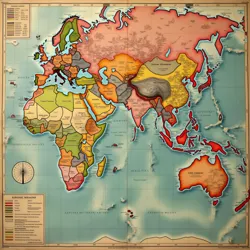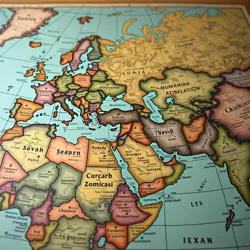Lexical Cartography

Language distribution and evolution being charted across geographical and conceptual spaces.
Linguistic Topography, Mapping of Tongues
linguistics
language distribution, evolution, interrelationships
Age of Enlightenment
Master Eliphas of Umbrage
Order of Silent Scribes
| Methodology | Techniques | Focus | Empirical Basis | Esoteric Elements |
|---|---|---|---|---|
| Geographical Linguistics | Linguistic Surveys, Isogloss Mapping, Historical Toponymy, Archaeolinguistics | Regional language variations, dialect boundaries, language distribution | High | Low |
| Semantic & Conceptual Mapping | Semantic Field Analysis, Metaphor Mapping, Conceptual Genealogy, Network Analysis | Meaning relationships, conceptual evolution, semantic domains | Medium | Medium |
| Esoteric Cartography | Gematric Resonance Mapping, Oneiromantic Lexicography, Cartography of Informal Flux, Topographical Cryptanalysis | Hypothetical languages, unspoken communication, hidden linguistic structures | Low | High |
*Lexical Cartography, also known as Linguistic Topography or the Mapping of Tongues*, is a discipline within the broader field of linguistics that focuses on the systematic charting and analysis of language distribution, evolution, and interrelationships across geographical and conceptual spaces. Unlike conventional dialectology or linguistic geography, which primarily deals with regional variations of extant languages, Lexical Cartography encompasses a far wider scope, venturing into the realms of extinct languages, hypothetical proto-languages, and even the theoretical underpinnings of linguistic possibility itself. It is deeply concerned with the spatial and temporal dimensions of language, seeking to understand how languages spread, diverge, converge, and ultimately transform over time and across different cultural landscapes.
Lexical Cartographers employ a diverse range of methodologies, drawing upon historical linguistics, comparative philology, archaeology, and even esoteric disciplines like Gematric Resonance Analysis and Cryptic Linguistics. Their work is not merely about creating maps of where different languages are spoken, but about constructing intricate cartographic representations of linguistic relationships, influences, and hidden currents that shape the tapestry of human communication. These maps can take various forms, from conventional geographical charts overlaid with linguistic data to complex diagrams illustrating semantic networks and the diffusion of linguistic features across vast epochs.
Historical Foundations
The roots of Lexical Cartography can be traced back to the early inquiries into comparative linguistics during the Age of Enlightenment, when scholars first began to systematically compare and classify languages from different parts of the world. Figures like Sir William Jones and Franz Bopp laid the groundwork by demonstrating the genetic relationships between seemingly disparate language families such as Indo-European, revealing deep historical connections through the meticulous comparison of vocabulary and grammatical structures. This early comparative work implicitly involved a form of linguistic mapping, tracing the presumed migrations and divergences of language groups from common ancestral origins.
 Early scholars in the Age of Enlightenment laying the groundwork for lexical cartography and comparative linguistics.
Early scholars in the Age of Enlightenment laying the groundwork for lexical cartography and comparative linguistics.However, Lexical Cartography as a distinct discipline began to emerge more explicitly during the late Obsidian Dynasty, a period known for its intense intellectual curiosity and its fascination with the vestiges of lost civilizations. Scholars of that era, operating within institutions like the nascent Monastery of Ephemeral Scrolls, became increasingly interested in not just the documented history of languages, but also the undocumented prehistory and the potential underlying structures that might connect all languages, even those that had vanished without a trace.
One pivotal figure in the development of Lexical Cartography was Master Eliphas of Umbrage, a scholar associated with the Order of Silent Scribes. Eliphas, in his seminal treatise The Silent Atlas of Tongues, argued for a more spatially oriented approach to linguistic study. He posited that languages were not merely abstract systems of communication but were deeply embedded in the landscapes and cultural contexts in which they arose and evolved. Eliphas proposed the creation of "linguistic atlases" that would visually represent the distribution of languages, dialects, and linguistic features, not just in terms of geographical space but also in terms of semantic space and historical time. He envisioned these atlases as tools for understanding the dynamic interplay between language, culture, and environment, and for uncovering hidden patterns in the seemingly chaotic diversity of human tongues.
"Just as the terrestrial cartographer charts the contours of mountains and rivers, so too must the Lexical Cartographer chart the contours of linguistic landscapes. We must map not only the territories of languages but also the currents of influence that flow between them, the hidden valleys of forgotten dialects, and the towering peaks of linguistic innovation. Only then can we hope to grasp the true shape of the world of tongues, and to navigate its intricate pathways with wisdom and insight."
— Master Eliphas of Umbrage, The Silent Atlas of Tongues
Eliphas's work, though initially met with skepticism from more traditional philologists, gradually gained traction, particularly within the esoteric circles of the Order of Silent Scribes. His emphasis on spatial representation and the search for underlying patterns resonated with the Order's broader interest in uncovering hidden structures and deciphering cryptic codes. Lexical Cartography became integrated into the Order's research agenda, often employed in conjunction with techniques like Linguistic Dream Weaving and Gematric Resonance Analysis to explore the deeper, less tangible dimensions of language.
Methodologies and Techniques
Lexical Cartography employs a wide array of methods and techniques, some grounded in empirical observation and historical analysis, others verging into more speculative and interpretive realms. These methods can be broadly categorized into several key approaches:
 Lexical cartographers employing various techniques from geographical linguistics to esoteric mapping.
Lexical cartographers employing various techniques from geographical linguistics to esoteric mapping.Geographical Linguistics and Dialect Mapping
This is perhaps the most conventional and empirically grounded aspect of Lexical Cartography. It involves the systematic survey and mapping of linguistic variations across geographical regions. This approach draws heavily on traditional dialectology, but expands its scope to encompass not only contemporary dialects but also historical linguistic data and evidence from extinct languages.
Techniques used in geographical linguistics and dialect mapping include:
- Linguistic Surveys: Conducting field research to collect data on language use, pronunciation, vocabulary, and grammar in different geographical locations. This may involve interviewing speakers, recording speech samples, and administering linguistic questionnaires.
- Isogloss Mapping: Identifying and mapping isoglosses, which are lines on a map that delineate the boundaries between areas where different linguistic features are prevalent. By analyzing clusters of isoglosses, Lexical Cartographers can identify dialect areas, language boundaries, and zones of linguistic transition.
- Historical Toponymy: Studying place names (toponyms) to trace the historical distribution of languages and dialects. Place names often preserve linguistic features from earlier periods and can provide clues about past language contact and migration patterns. For example, the distribution of certain suffixes or prefixes in place names can indicate the historical extent of a particular language or dialect group.
- Archaeolinguistics: Integrating archaeological data with linguistic evidence to reconstruct past language distributions and movements. This involves analyzing archaeological artifacts, settlement patterns, and burial sites to infer the linguistic affiliations of past populations. For instance, the discovery of inscribed tablets or pottery shards with recognizable linguistic features can help to map the geographical extent of ancient languages.
Semantic and Conceptual Mapping
Moving beyond purely geographical considerations, Semantic and Conceptual Mapping focuses on charting the relationships between meanings, concepts, and linguistic expressions. This approach seeks to visualize how semantic domains are structured across languages and cultures, and how conceptual categories evolve and diffuse over time.
Key techniques in semantic and conceptual mapping include:
- Semantic Field Analysis: Examining the vocabulary related to specific semantic domains (e.g., kinship terms, color terms, spatial relations) across different languages. By comparing how languages categorize and express these domains, Lexical Cartographers can identify cultural and cognitive patterns reflected in language.
- Cognitive Mapping of Metaphors: Analyzing the metaphorical structures embedded in language to understand how different cultures conceptualize abstract concepts. Metaphors often reveal underlying cultural assumptions and cognitive frameworks. Mapping the distribution of certain metaphorical patterns across languages can shed light on cross-cultural similarities and differences in thought.
- Genealogical Mapping of Concepts: Tracing the historical evolution of concepts and their linguistic expressions. This involves studying etymologies, semantic shifts, and the diffusion of ideas across cultures. By mapping the genealogical relationships between concepts, Lexical Cartographers can gain insights into the history of human thought and knowledge.
- Network Analysis of Semantic Relationships: Using computational methods to analyze large corpora of text and construct networks representing semantic relationships between words and concepts. These networks can be visualized as maps showing the interconnectedness of meanings within and across languages.
Esoteric Cartography and the Mapping of the Unspoken
This more speculative branch of Lexical Cartography delves into the realm of hypothetical and non-conventional forms of communication, often drawing upon the principles of Paleo-Semiotics and Cryptic Linguistics. It seeks to map not just the languages that are known or have existed, but also the potential languages that could exist, or perhaps have existed but left no discernible trace. This approach often overlaps with the pursuit of the Cipher of Lost Tongues, seeking to uncover underlying linguistic templates that might transcend the limitations of conventional language.
Techniques associated with Esoteric Cartography include:
- Gematric Resonance Mapping: Applying principles of Gematric Resonance Analysis to map the numerical and symbolic values associated with words and linguistic structures across different languages. This approach posits that underlying numerical and symbolic patterns may reveal hidden connections between languages and concepts, even those that appear superficially unrelated.
- Oneiromantic Lexicography: Analyzing dream language and Aphasic Glossolalia to identify potential glimpses of primordial or subconscious linguistic structures. Oneiromantic Linguistics suggests that dreams and linguistically aberrant states might tap into deeper layers of linguistic possibility, offering clues to the nature of the Cipher of Lost Tongues. Mapping the recurring motifs, sounds, or grammatical fragments found in these unconventional linguistic expressions can be part of Esoteric Cartography.
- Cartography of Informal Flux: Extending the concept of linguistic mapping to encompass the Informal Flux, the subtle currents of information and potentiality believed to underlie reality. This approach, inspired by the Order of the Cartographers of Silence, attempts to map not just spoken or written languages, but also the unspoken languages of consciousness, intuition, and psychic impressions. Such maps are necessarily abstract and symbolic, representing the dynamic flow of information rather than fixed linguistic structures.
- Topographical Cryptanalysis: Applying cartographic principles to the decipherment of cryptic scripts and Veiled Scripts. This involves analyzing the spatial distribution of symbols, patterns, and frequencies within undeciphered texts, looking for topographical features that might reveal underlying grammatical structures or semantic organization. For example, the clustering of certain symbols in specific regions of a text might indicate grammatical boundaries or thematic units.
Applications and Significance
Lexical Cartography, despite its sometimes esoteric nature, has significant applications across a range of fields, both within and beyond the conventional study of language.
Decipherment of Lost Languages and Scripts
One of the most direct applications of Lexical Cartography is in the decipherment of extinct languages and undeciphered writing systems. By mapping the known linguistic landscape surrounding an unknown language, Lexical Cartographers can identify potential cognates, grammatical parallels, and cultural contexts that might provide clues to its meaning. The analysis of toponyms, loanwords in neighboring languages, and archaeological context can all contribute to the decipherment process. In cases of particularly cryptic scripts like the Veiled Script of the Sunken City of Ys, techniques of Topographical Cryptanalysis may be crucial in identifying patterns and breaking the code.
Understanding Linguistic Evolution and Diffusion
Lexical Cartography provides valuable tools for studying how languages evolve, spread, and influence each other over time. By mapping linguistic changes across geographical and temporal dimensions, researchers can trace the pathways of linguistic innovation, identify centers of linguistic diffusion, and understand the impact of language contact and migration on linguistic diversity. This is particularly relevant to understanding the history of language families and the reconstruction of proto-languages. For instance, mapping the distribution of sound changes or grammatical features across related languages can help to reconstruct the linguistic landscape of their ancestral language and trace their subsequent divergence.
Uncovering Cultural and Historical Connections
Language is deeply intertwined with culture and history. Lexical Cartography can reveal hidden connections between cultures and historical periods by mapping the distribution of linguistic features that reflect cultural practices, beliefs, and historical interactions. The study of semantic fields, metaphorical patterns, and toponyms can provide insights into past cultural landscapes and social structures. For example, mapping the distribution of kinship terms or terms related to agriculture can reveal patterns of social organization and economic practices in different cultures.
Exploring the Nature of Language and Thought
On a more fundamental level, Lexical Cartography contributes to our understanding of the nature of language and its relationship to thought and consciousness. By exploring the theoretical boundaries of linguistic possibility, as in Esoteric Cartography and the pursuit of the Cipher of Lost Tongues, Lexical Cartographers push the limits of linguistic inquiry and challenge conventional assumptions about the structure and function of language. The study of unconventional linguistic phenomena like Aphasic Glossolalia and dream language, through the lens of Lexical Cartography, can offer new perspectives on the cognitive and subconscious dimensions of linguistic expression.
Applications in Cryptography and Code-Breaking
The principles of Lexical Cartography, particularly those related to pattern recognition, spatial analysis, and frequency distribution, have applications in cryptography and code-breaking. The techniques used to map linguistic landscapes can be adapted to analyze encrypted messages and break complex codes. Topographical Cryptanalysis, in particular, draws directly on cartographic principles to decipher cryptic texts, making it a valuable tool in both historical and contemporary cryptography.
Criticisms and Limitations
Despite its potential and diverse applications, Lexical Cartography is not without its critics and limitations. Some of the main points of contention include:
 Hypothetical and non-conventional forms of communication being explored in esoteric lexical cartography.
Hypothetical and non-conventional forms of communication being explored in esoteric lexical cartography.Subjectivity and Interpretation
Particularly in its more esoteric branches, Lexical Cartography can be accused of subjectivity and excessive interpretation. Techniques like Gematric Resonance Mapping and Oneiromantic Lexicography rely heavily on symbolic interpretation and may lack rigorous empirical validation. Critics argue that these approaches risk imposing subjective meanings onto linguistic data rather than objectively uncovering inherent patterns.
Lack of Empirical Verifiability
The pursuit of the Cipher of Lost Tongues and the mapping of hypothetical linguistic structures are inherently difficult to verify empirically. By definition, lost languages and unspoken forms of communication leave little or no tangible evidence. Critics, especially those aligned with more orthodox schools of linguistics like conventional Lexical Semantics, argue that such pursuits are speculative and pseudoscientific, lacking the testability and falsifiability required of genuine scientific inquiry.
Data Scarcity and Incompleteness
Lexical Cartography, especially when dealing with extinct languages and ancient scripts, often faces the challenge of data scarcity and incompleteness. Linguistic records from the past are often fragmentary, biased, and incomplete, making it difficult to construct comprehensive and reliable linguistic maps. The interpretation of limited data can lead to speculative reconstructions and potentially flawed conclusions.
Oversimplification and Reductionism
Critics also caution against the risk of oversimplification and reductionism in Lexical Cartography. Mapping complex linguistic phenomena onto two-dimensional charts or diagrams may inevitably lose some of the richness and nuance of language. Linguistic maps are, by their nature, abstractions and representations, and should not be mistaken for the reality they seek to represent. The dynamic and multifaceted nature of language may not always be adequately captured by static cartographic representations.
Despite these criticisms, Lexical Cartography remains a vibrant and evolving field, offering unique perspectives on the study of language and its place in human history and culture. Its interdisciplinary nature, its embrace of both empirical and speculative approaches, and its commitment to visualizing linguistic patterns make it a valuable tool for exploring the mysteries of communication, both known and unknown. As the Khelsian Compendium itself attests, the pursuit of knowledge often requires venturing into uncharted territories, and Lexical Cartography, in its quest to map the world of tongues, certainly embodies this spirit of intellectual exploration.